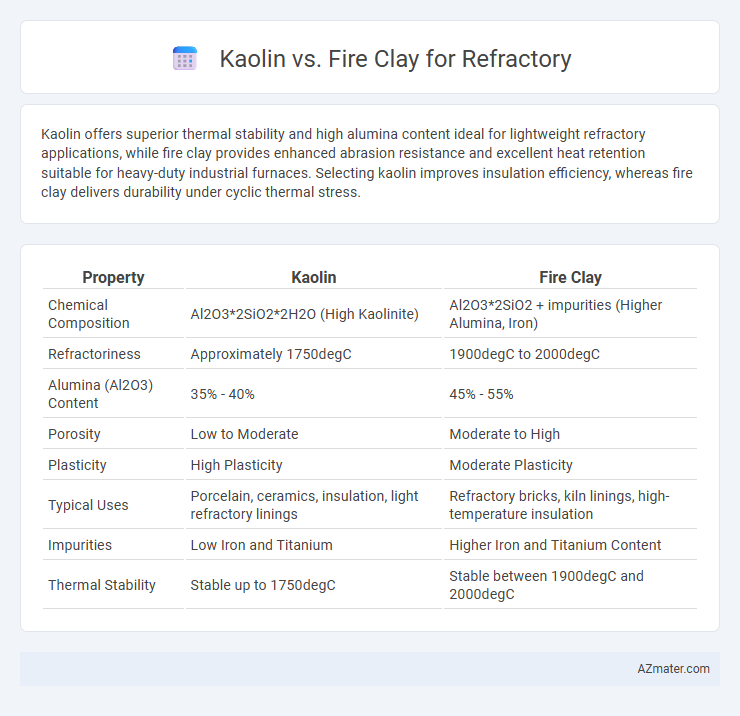Kaolin offers superior thermal stability and high alumina content ideal for lightweight refractory applications, while fire clay provides enhanced abrasion resistance and excellent heat retention suitable for heavy-duty industrial furnaces. Selecting kaolin improves insulation efficiency, whereas fire clay delivers durability under cyclic thermal stress.
Table of Comparison
| Property | Kaolin | Fire Clay |
|---|---|---|
| Chemical Composition | Al2O3*2SiO2*2H2O (High Kaolinite) | Al2O3*2SiO2 + impurities (Higher Alumina, Iron) |
| Refractoriness | Approximately 1750degC | 1900degC to 2000degC |
| Alumina (Al2O3) Content | 35% - 40% | 45% - 55% |
| Porosity | Low to Moderate | Moderate to High |
| Plasticity | High Plasticity | Moderate Plasticity |
| Typical Uses | Porcelain, ceramics, insulation, light refractory linings | Refractory bricks, kiln linings, high-temperature insulation |
| Impurities | Low Iron and Titanium | Higher Iron and Titanium Content |
| Thermal Stability | Stable up to 1750degC | Stable between 1900degC and 2000degC |
Introduction to Kaolin and Fire Clay
Kaolin is a white, fine-grained clay mineral primarily composed of the mineral kaolinite, known for its high alumina content and excellent thermal stability, making it suitable for refractory applications requiring resistance to high temperatures and chemical corrosion. Fire clay contains a mixture of kaolinite and other minerals with a higher silica content, offering greater strength and thermal resistance, commonly used in producing firebricks and insulating materials for furnaces and kilns. Both materials are essential in refractory industries, with kaolin favored for its purity and fire clay valued for durability and heat resistance under extreme conditions.
Chemical Composition and Mineralogy
Kaolin primarily consists of the mineral kaolinite (Al2Si2O5(OH)4), characterized by a high alumina (Al2O3) content around 40-45% and low iron oxide, contributing to its white color and excellent refractory properties. Fire clay contains a more complex mineralogy with higher amounts of mullite (3Al2O3*2SiO2) and quartz (SiO2), exhibiting alumina content typically between 30-40% and greater silica levels, which enhance its thermal shock resistance and structural strength. The chemical composition differences result in kaolin's suitability for billets and coatings, while fire clay is preferred for heavy-duty refractory linings exposed to mechanical wear and high temperatures.
Thermal Properties Comparison
Kaolin exhibits a higher refractory temperature, typically withstanding up to 1790degC, while fire clay endures temperatures around 1560degC, making kaolin more suitable for extreme heat resistance. Kaolin's thermal conductivity is lower, providing better insulation and reducing heat transfer in refractory applications compared to fire clay. Fire clay offers greater thermal shock resistance due to its higher alumina content and structural composition, enhancing durability under rapid temperature changes.
Mechanical Strength and Durability
Kaolin-based refractories exhibit higher mechanical strength due to their fine particle size and high alumina content, resulting in superior load-bearing capacity and resistance to thermal shock. Fire clay refractories, while having good plasticity and resistance to chemical attack, generally offer lower mechanical strength and durability under high-temperature cycling compared to kaolin. The enhanced sintering properties of kaolin contribute to denser, less porous refractory products, which significantly improve durability and lifespan in high-temperature industrial applications.
Refractoriness and High-Temperature Performance
Kaolin exhibits excellent refractoriness with melting points around 1750degC, making it ideal for environments requiring moderate thermal resistance in refractory applications. Fire clay offers superior high-temperature performance, withstanding up to 1790degC and demonstrating exceptional thermal stability and resistance to thermal shock. The higher alumina content in fire clay enhances its refractory properties, ensuring durability in intensive heating conditions compared to kaolin.
Industrial Applications of Kaolin
Kaolin offers superior purity and consistent particle size, making it ideal for high-temperature refractory linings in industrial furnaces, kilns, and reactors. It provides excellent thermal stability, low thermal expansion, and resistance to chemical corrosion, enhancing the lifespan and performance of refractory products in steelmaking and glass manufacturing. Fire clay, while durable, has a coarser structure and higher impurities, limiting its use in precision applications where kaolin's refined properties are essential for thermal insulation and structural integrity.
Industrial Uses of Fire Clay
Fire clay is widely used in high-temperature industrial applications due to its excellent refractory properties, including high melting points and resistance to thermal shock, making it ideal for furnace linings, kiln furniture, and firebricks. It contains a higher proportion of alumina compared to kaolin, enhancing durability in steel manufacturing, cement production, and glass melting industries. The superior mechanical strength and heat resistance of fire clay ensure prolonged service life in harsh industrial environments.
Cost Considerations and Availability
Kaolin and fire clay serve distinct roles in refractory applications, with kaolin generally being more expensive due to its higher purity and specialized processing requirements. Fire clay is more abundantly available and offers a cost-effective solution for refractory linings, especially in applications demanding high heat resistance but less chemical purity. The choice between kaolin and fire clay largely hinges on project budget constraints and required material performance, with fire clay preferred for economical bulk applications and kaolin reserved for premium, high-temperature environments.
Environmental Impact and Sustainability
Kaolin offers a lower environmental impact than fire clay due to its higher purity, which reduces the need for intensive processing and energy consumption in refractory production. Fire clay, while abundant and versatile, often involves more extensive mining and processing, leading to greater land disturbance and carbon emissions. Sustainable refractory manufacturing increasingly favors kaolin to minimize ecological footprints and enhance material recyclability.
Choosing the Right Material for Your Refractory Needs
Kaolin offers high purity and excellent thermal stability, making it ideal for applications requiring precise heat resistance and minimal impurities. Fire clay, known for its toughness and ability to withstand mechanical stress, is better suited for heavy-duty refractory linings and industrial furnaces. Selecting between kaolin and fire clay depends on the specific temperature range, chemical exposure, and mechanical requirements of your refractory application.

Infographic: Kaolin vs Fire clay for Refractory
 azmater.com
azmater.com